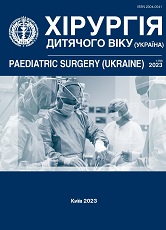Surgical correction of congenital kyphosis in children. Clinical case
DOI:
https://doi.org/10.15574/PS.2023.78.135Keywords:
congenital kyphosis, deformity correction, vertebral decancellation, posterior fusion, rod fractureAbstract
Congenital kyphosis occurs as a result of a disorder of vertebral formation or segmentation. There are a number of scientific papers that evaluate and compare various methods of surgical treatment of patients with congenital kyphosis, as well as analyze complications in this group of patients. In the current literature, preference is given to methods with more aggressive correction of angular kyphotic deformity, in particular, corrective spinal osteotomies and various types of vertebrectomy. These methods can achieve significant deformity correction, but have a high risk of complications associated with fractures of the fixation rods in the long-term postoperative period.
Purpose - to present a clinical case of surgical treatment of a patient with congenital kyphosis, which allowed to achieve significant correction of the deformity and reduce the number of complications associated with the instability of the metal structure.
The clinical case describes the treatment of a 16-year-old patient with an active Th11 wedge-shaped halve vertebrae using the method of decancellation the latter and fixing the spine with a transpedicular metal structure. The peculiarity of the surgical intervention is the use of rib fragments as an autograft to form a posterior spondylodisc.
Conclusions. The use of rib fragments as an autograft creates conditions for the formation of a posterior bone block, which reduces the risk of fracture of the fixation rods in the long-term postoperative period.
The research was carried out in accordance with the principles of the Helsinki Declaration. The informed consent of the patient was obtained for conducting the studies.
No conflict of interests was declared by the authors.
References
Giampietro PF, Blank RD, Raggio CL et al. (2003). Congenital and idiopatic scoliosis, clinical and genetic aspects. Clin Med Res. 1 (2): 125-136. https://doi.org/10.3121/cmr.1.2.125; PMid:15931299 PMCid:PMC1069035
Jianguo Z, Shengru W, Guixing Q et al. (2011). The efficacy and complications of posterior hemivertebra resection. Eur Spine J. 20 (10): 1692-1702. https://doi.org/10.1007/s00586-011-1710-0; PMid:21318279 PMCid:PMC3175869
Jianwei G, Jianguo Z, Shengru W et al. (2016). Risk factors for construct/implant related complications following primary posterior hemivertebra resection: Study on 116 cases with more than 2 years' follow-up in one medical center. BMC Musculoskelet Disord. 17 (1): 380. https://doi.org/10.1186/s12891-016-1229-y; PMid:27589864 PMCid:PMC5010738
Kim YJ, Otsuka NY, Flynn JM, Hall JE, Emans JB, Hresko MT. (2001, Oct 15). Surgical treatment of congenital kyphosis. Spine. 26 (20): 2251-2257. https://doi.org/10.1097/00007632-200110150-00017; PMid:11598516
Levytskyi AF, Rogozinskyi VA, Dolianytskyi MM. (2020). Halo-gravity traction in the treatment of complex (>100°) scoliotic deformities of the spine in children: a review of clinical cases. Paediatric Surgery. Ukraine. 4 (69): 67-71. https://doi.org/10.15574/PS.2020.69.67
McMaster MJ, Ohtsuka K. (1982). The natural history of congenital scoliosis. A study of two hundred and fifty-one patients. J Bone Joint Surg Am. 8: 1128-1147. https://doi.org/10.2106/00004623-198264080-00003
McMaster MJ, Singh H. (2001, Oct 1). The surgical management of congenital kyphosis and kyphoscoliosis. Spine. 26 (19): 2146-2154; discussion 2155. https://doi.org/10.1097/00007632-200110010-00021; PMid:11698894
McMaster MJ. (2006, Sep 15). Spinal growth and congenital deformity of the spine. Spine. 31 (20): 2284-2287. https://doi.org/10.1097/01.brs.0000238975.90422.c4; PMid:16985453
Noordeen MH, Garrido E, Tucker SK, Elsebaie HB. (2009, Aug 1). The surgical treatment of congenital kyphosis. Spine. 34 (17): 1808-1814. https://doi.org/10.1097/BRS.0b013e3181ab6307; PMid:19644332
Qi Q, Chen ZQ, Guo ZQ, Li WS. (2006, Apr 15). New type spinal osteotomy with cage inserting anteriorly and closing posteriorly to correct thoracolumbar kyphosis by a single posterior approach. Zhonghua Wai Ke Za Zhi. 44 (8): 551-555.
Ruf M, Jensen R, Letko L et al. (2009). Hemivertebra resection and osteotomies in congenital spine deformity. Spine. 34 (17): 1791-1799. https://doi.org/10.1097/BRS.0b013e3181ab6290; PMid:19644330
Shands AR, Bundens WD. (1956). Congenital deformities of the spine; an analysis of the roentgenograms of 700 children. Bull Hosp Jt Dis. 17 (2): 110-133.
Spiro AS, Rupprecht M, Stenger P, Hoffman M, Kunkel P, Kolb JP, Rueger JM, Stuecker R. (2013, Nov). Surgical treatment of severe congenital thoracolumbar kyphosis through a single posterior approach. Bone Joint J. 95-B (11): 1527-1532. https://doi.org/10.1302/0301-620X.95B11.31376; PMid:24151274
Suk SI, Chung ER, Lee SM et al. (2005). Posterior vertebral column resection for severe spinal deformities. Spine. 30 (23): 703-710. https://doi.org/10.1097/01.brs.0000188190.90034.be; PMid:16319740
Tsou PM. (1977, Oct). Embryology of congenital kyphosis. Clin Orthop Relat Res. 128: 18-25. https://doi.org/10.1097/00003086-197710000-00004
Willems KF, Slot GH, Anderson PG et al. (2005). Spinal osteotomy in patients with ankylosing spondylitis: complications during first postoperative year. Spine. 30 (1): 101-107. https://doi.org/10.1097/00007632-200501010-00018; PMid:15626989
Yang BH, Li HP, He XJ, Zhao B, Zhang C, Zhang T, Huang SH. (2014, May). Total vertebral column resection combined with anterior mesh cage support for the treatment of severe congenital kyphoscoliosis. Zhongguo Gu Shang. 27 (5): 358-362.
Zeng Y, Chen Z, Qi Q, Guo Z, Li W, Sun C, Liu N. (2013, Feb). The posterior surgical correction of congenital kyphosis and kyphoscoliosis: 23 cases with minimum 2 years follow-up. Eur Spine J. 22 (2): 372-378. https://doi.org/10.1007/s00586-012-2463-0; PMid:22875579 PMCid:PMC3555610
Zhang J, Shengru W, Qiu G, Yu B, Yipeng W, Luk KD. (2011, Oct). The efficacy and complications of posterior hemivertebra resection. Eur Spine J. 20 (10): 1692-1702. https://doi.org/10.1007/s00586-011-1710-0; PMid:21318279 PMCid:PMC3175869
Downloads
Published
Issue
Section
License
Copyright (c) 2023 Paediatric Surgery (Ukraine)

This work is licensed under a Creative Commons Attribution-NonCommercial 4.0 International License.
The policy of the Journal “PAEDIATRIC SURGERY. UKRAINE” is compatible with the vast majority of funders' of open access and self-archiving policies. The journal provides immediate open access route being convinced that everyone – not only scientists - can benefit from research results, and publishes articles exclusively under open access distribution, with a Creative Commons Attribution-Noncommercial 4.0 international license(СС BY-NC).
Authors transfer the copyright to the Journal “PAEDIATRIC SURGERY.UKRAINE” when the manuscript is accepted for publication. Authors declare that this manuscript has not been published nor is under simultaneous consideration for publication elsewhere. After publication, the articles become freely available on-line to the public.
Readers have the right to use, distribute, and reproduce articles in any medium, provided the articles and the journal are properly cited.
The use of published materials for commercial purposes is strongly prohibited.

